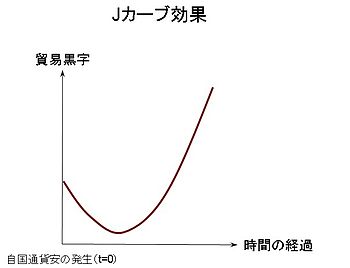Marshall-Lerner condition
Marshall-Lerner condition
The Marshall-Lerner condition refers to the impact of a depreciation, or devaluation, of a currency on the current account of the balance of payments. The condition states that the current account will improve, after a depreciation, if the sum of the price elasticities of demand for imports and exports is greater than 1. The further above 1 the sum of the elasticities is, the greater the improvement in the current account will be.
Marshall-Lerner condition - explanation

The depreciation of a currency will increase import prices and decrease export prices. Therefore, the more price elastic the demand for imports and exports, the greater will be the fall in demand for imports and the increase in demand for exports and the greater will be the improvement on the current account.

J-curve
Evidence around the world suggests that the Marshall-Lerner condition does not hold in the short-run, but does in the medium- to long-run. This is because in the short-run, there will be few extra exports sold when prices fall - people overseas do not react immediately and so export demand will take time to change. However, extra money will have to be paid for imports immediately and so the current account will tend to deteriorate. In the medium term, however, the lower export prices will lead to an increase in demand for exports and so the current account will start to improve. The price elasticity of demand for exports is lower in the short-run, but will be higher in the long-run.
This leads to the pattern shown in Figure 1 below - an initial deterioration of the trade balance followed by an improvement.

Figure 1 J-curve



2 Comments:
628 金持ち名無しさん、貧乏名無しさん (ワッチョイ 0dc9-RKKU)[] 2021/04/06(火) 19:21:06.00 ID:5LngcCbu0
最適通貨圏
https://ja.wikipedia.org/wiki/%E6%9C%80%E9%81%A9%E9%80%9A%E8%B2%A8%E5%9C%8F
最適通貨圏の理論はロバート・マンデルによって提唱された[3][4]。 通常、マンデルが最適通貨圏の理論の最初の提唱者
だとされるが、一部でアバ・ラーナーによるマンデルよりも早い研究があったと指摘されることがある[5]。
アバ・ラーナー
https://ja.wikipedia.org/wiki/%E3%82%A2%E3%83%90%E3%83%BB%E3%83%A9%E3%83%BC%E3%83%8A%E3%83%BC
業績
マーシャル・ラーナー条件
https://cruel.org/econthought/profiles/lerner.html
ラーナーは経済理論と政策に無数の貢献をしたので、20世紀で最も影響力の高い経済学者の一人といえる――とはいえ、学会政治ができないという好感の持てる性格のために、伝統的なキャリアが積めないのは必定だった。初期の貢献はまだ学生時代のものだが、国際貿易理論と一般均衡理論についてのものだった。1932年の論文はハーバラーの生産可能性フロンティアとマーシャルの提供曲線 (offer curves) と パレートの無差別曲線を、国際貿易の2セクターモデルに導入した。これを受けた1934年論文は、その後の国際貿易理論の基本的な提示方法を確立した。また同じく1934年に、ラーナーは「要素価格均等化」理論 ("factor price equalization" theorem) を見つけた。これは後の1948年に サミュエルソン が再発見しているが、彼はこれを1952年まで発表してない。1936 年の論文は、輸出関税と輸入関税の対称性に関する昔からの直感を証明するものだった。
1934年にラーナーは、一般均衡生産経済における完全なパレート最適性条件を明らかにする、彼のもっとも見事な論文の一つを書いている――特に、あのきわめて重要な 効率性についてのパレートルール, つまり価格が限界費用と等しい
P
=
M
C
P
=
M
C
を明らかにしている。またここで、ラーナーは「独占の度合い」という考え方を発表した。これは価格が限界費用からどのくらいずれるかで示される。
パレート派理論への大きな貢献もあって、かれはオスカール・ランゲとともに「社会主義計算論争」 (1934, 1935, 1936, 1937, 1938, 1944) に加わった。ラーナーは、
P
=
M
C
P
=
M
C
ルールにしたがって効率性を高めるべきだと論じ、これは社会主義だろうと自由市場だろうと実現できるのだと述べた。そして結果として、社会計画者が左右できるのは、所得の最初の分配だけなのだ、と強調し、結果として生じる配分は完全競争市場以上の効率性は実現できないという。ラーナーは、パレート派一般均衡系の美しさと効率性を確信していた――だがそれが理想論でしかなくめったに実現されないものだと認識できるほどには正気だった――したがって社会主義にも一理あるというわけだ。だがこれについてあまり教条主義的ではなかった。ラーナーは経済民主主義と消費者の選択の重要性を信じていて、民間企業のほうが効率が高いとわかれば、社会主義経済のどんな産業でも民間企業に任せるべきだと論じた。
コメントを投稿
<< Home